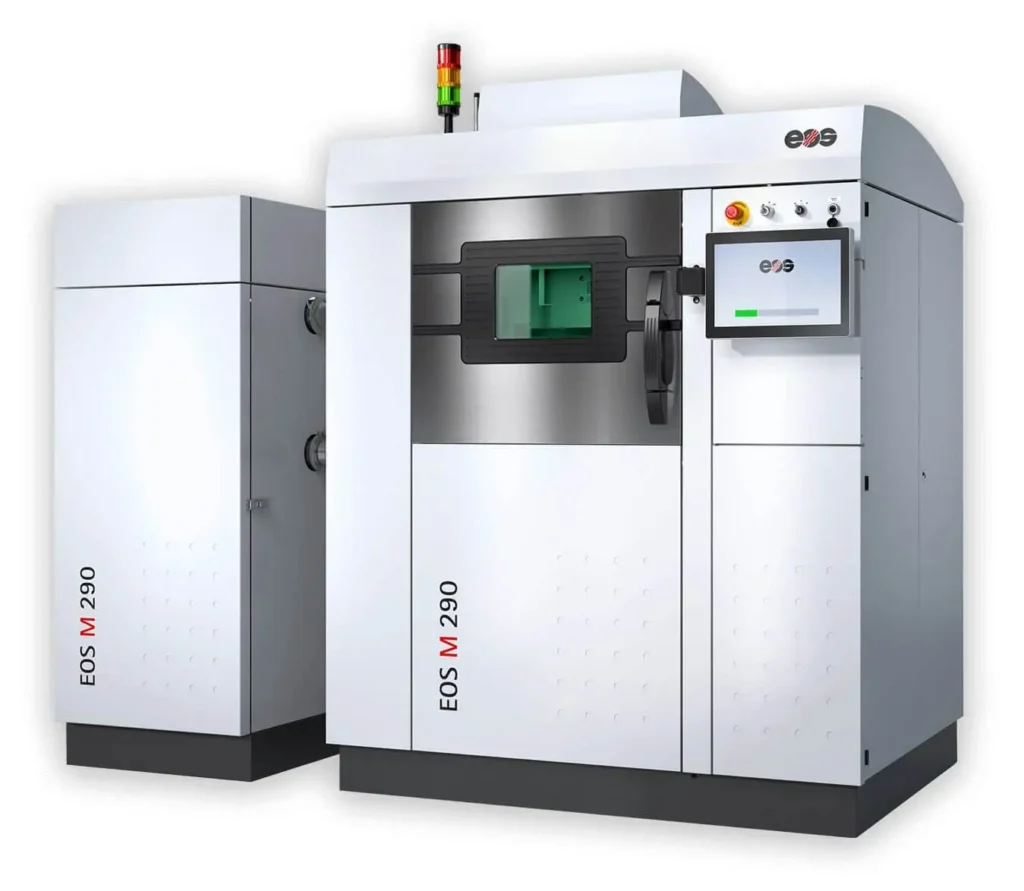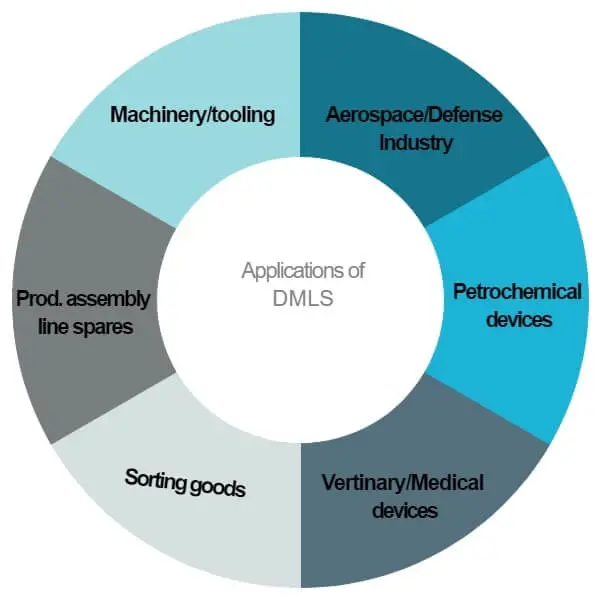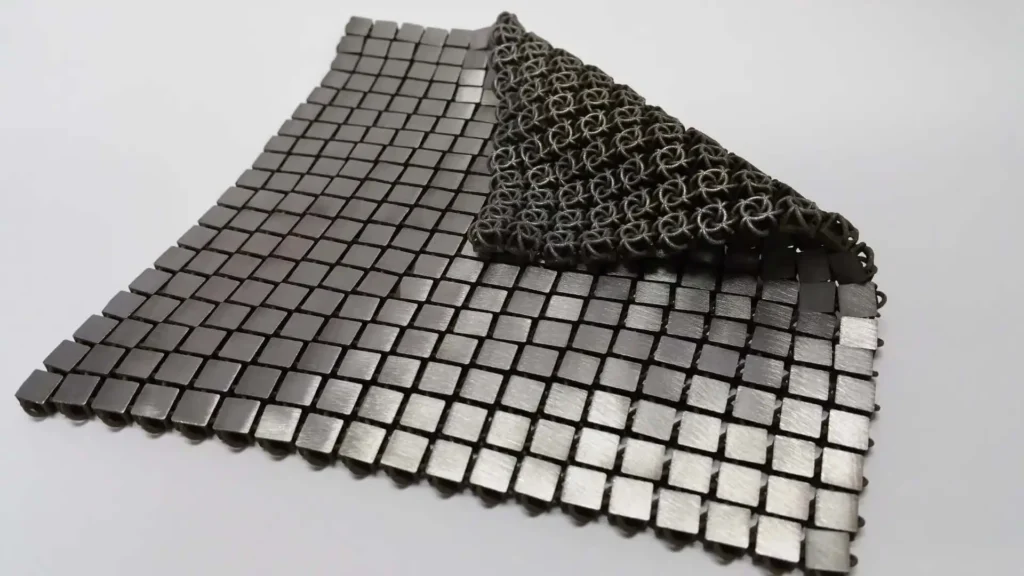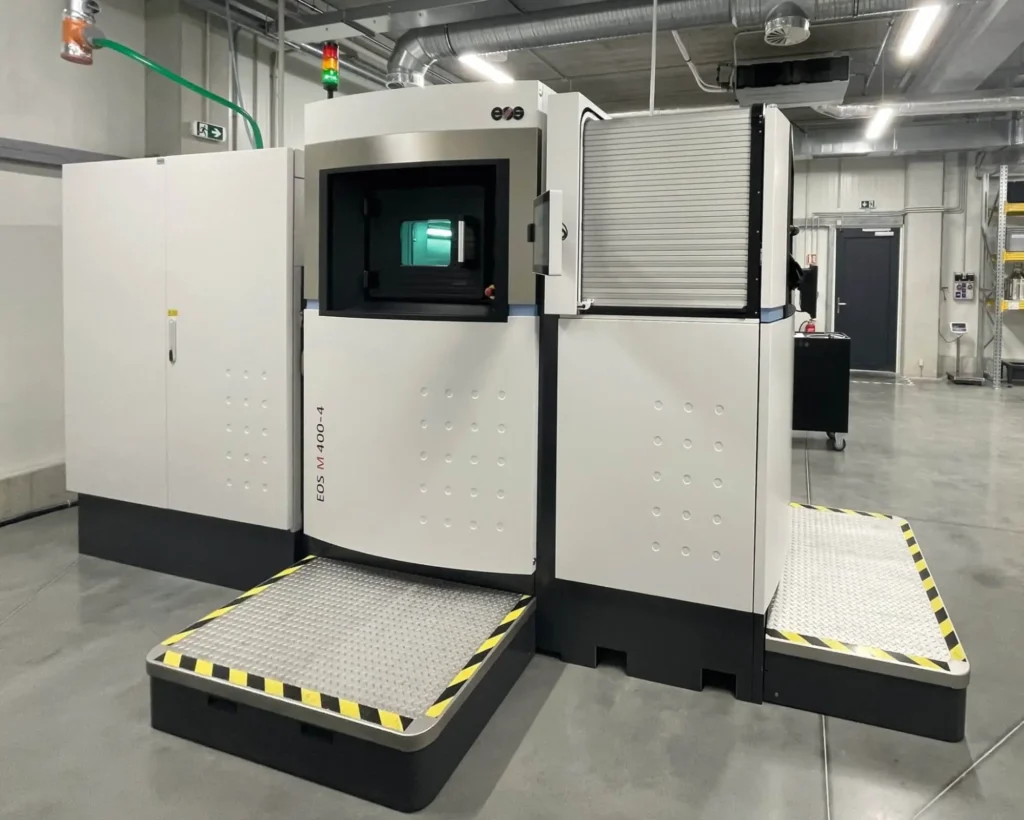Similar to selective laser sintering (SLS) in terms of the underlying process ( i-e. selective sintering of the material to build object layer by layer), direct metal laser sintering (DMLS) is another commercially available 3D printing technology. As its name implies, it is a laser-based material additive technology.
Introduction to DMLS
Developed by EOS back in 1995, DMLS uses materials that are metallic powders compared to SLS which can process a range of materials such as polymers, ceramics, metals, and alike. Another difference between the two lies in the production of the metal parts independent of a binder coating and therefore post-processing requirements. Some of the differences between DMLS and SLS are mentioned in the figure below.

The figure shown below illustrates a DMLS machine designed and fabricated by EOS.

DMLS Materials
Unlike SLS and SLM which are primarily based on powder-bed fusion technology, and others such as carbon DLS technology and stereolithography (SLA) which focus on (liquid) resins as process material, DMLS is specific to the use of metals some of which include cobalt chromium, titanium alloys, steel alloys, tool steels, etc.
How does DMLS work?
As shown below, on the build platform, a thin layer of the metallic powder is evenly distributed. A high-powered laser scans the digital image of the to-be-printed object and selectively melts and fuses the metallic powder by sintering.
The build platform now lowers a little depending upon the thickness of the subsequent layer thereby letting a new layer of the powder form. Sintering of this new layer will now follow and then the process will start again layer after layer until the whole object is printed. After the sintering of each layer, the metal cools off and solidifies.
In case of overhanging or complex geometries, support structures may be added during the printing process. Once the object is fully printed, it is withdrawn from the powder bed and is subject to post-processing such as removing support structures, thermal curing or machining for surface finishing, and so forth.

Initially, this printing technique was adopted for producing tooling. However, over the period, it was used in the production of end-use products. The figure below illustrates the schematic of the DMLS process.
The properties of the DMLS parts are in most cases comparable with those of the cast or the injection molded parts.
For overhanging features, support structures are required; whereas anchors are used keeping in view the high thermal stresses involved. Akin to SLS, these support structures require enough post-processing operations.
Unlike FDM which is most commonly used for prototyping and rapid manufacturing of somewhat less intricate plastic parts, DMLS is useful in the production of metal parts (in addition to SLM and EBM) yet with extreme complex geometries that are somewhat challenging to build using traditional means.
Applications of DMLS
DMLS can produce parts from small to large quantities: from prototypes to as high production volumes as 20,000 units.

It offers cutting-edge 3DP technology for printing objects used in the aerospace and automotive industries. Nonetheless, its widespread applications include producing machinery, tooling, petrochemicals, automotive, and medical devices. Moreover, it produces air/fuel/oil mixers, sporting goods, radiation collimators, and the like.
The European Space Agency (EPA) produces parts using DMLS such as injectors, combustion chambers, expansion nozzles, and others for its bi-propellent communication satellite engine. In collaboration with 3D systems. In the process of new product development, they however made substantive changes to reducing part weight, making assembly simpler, increasing the speed of manufacturing, and accommodating the late-stage design modifications.
The figure illustrated below demonstrates metallic space fabrics made using DMLS by NASA. The printed object is the one-piece part with sintering metals printed layer upon layer. Such fabrics are no ordinary objects. They are used in space in addition to large antennas due to the changeability of their shape. These fabrics are moreover used in protecting spacecraft from meteorites as well as for astronaut’s spacesuits and in capturing objects located on the surface of a foreign planet. They are also found on icy moons like Jipeter’s Europa where such fabrics are used for insulating the spacecraft.

For more complex industrial applications, the ECOS M 400-4 – a new DMLS machine was designed and fabricated by EOS (figure below). It is equipped with four 400W lasers capable of generating about four times more productivity in operation.

It is efficient enough to give large build volumes of 400×400×400 mm with as high production speed as 100 cubic centimeters per hour. For this machine, a range of materials can be processed such as light metals, SS to superalloys.
Advantages and Disadvantages of DMLS
There are numerous advantages of the DMLS method. These include printing objects with complex and intricate geometries such as space fabrics by NASA for rapid prototyping and minimal wastage of metallic powder among many others. Likewise, there are also certain demerits of DMLS such as limitations on the side of the processing materials, compromised surface finish, somewhat difficult powder handling, and others as shown in the figure below.

Frequently Asked Questions
What is direct metal laser sintering?
It is very similar to the SLS: It prints parts using a laser beam by sintering metallic powders layer upon layer.
What is an account for direct metal laser sintering vs selective laser melting?
Both are material additive technologies. However, in DMLS the metallic powder is melted below its melting point to sinter particles together. Whereas in selective laser melting, the particles are fully melted above their melting point to bond them fully together.
What is the balling effect in direct metal laser sintering?
It refers to the partial melting of the metallic particles thus taking the shape of the spherical structures which clump together as a result of the additive manufacturing process.
How does direct metal laser sintering work?
It builds 3D parts by selectively sintering the metallic powders using a laser beam layer by layer.
I am the author of Mechanical Mentor. Graduated in mechanical engineering from University of Engineering and Technology (UET), I currently hold a senior position in one of the largest manufacturers of home appliances in the country: Pak Elektron Limited (PEL).
